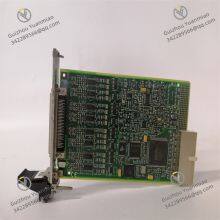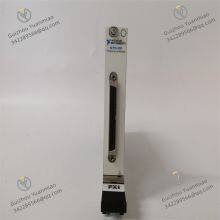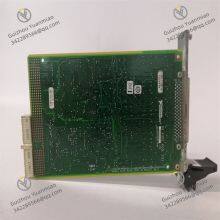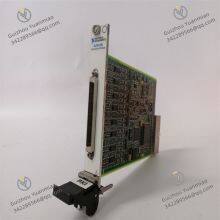Material
Other, Global universal model
Condition
Other, Global universal model
Task
Other, Global universal model
Mathematical Model
Other, Global universal model
Signal
Other, Global universal model
Customized
Non-Customized
Structure
Other, Global universal model
NI PXI-4351I. Product Positioning and Core Functions
The NI PXI-4351 is a PXI bus analog input module designed for high-precision measurement of physical quantities such as strain, force, and pressure. It can be integrated into PXI/PXI Express systems, suitable for scenarios like structural health monitoring, material testing, and industrial automation. Its core advantages include:
High-Precision Signal Conditioning and Acquisition: Built-in 24-bit ADC supports bridge excitation and synchronous dynamic signal acquisition, meeting the measurement requirements for microvolt-level strain signals.
Multi-Channel Synchronous Measurement: 8 differential input channels support synchronous sampling, suitable for multi-point stress analysis (e.g., bridge and aerospace component monitoring).
Bridge Excitation and Compensation: Integrates 2.5V/5V/10V bridge voltage excitation, supports full-bridge/half-bridge/1/4-bridge configurations, and automatically compensates for temperature drift and bridge imbalance.
Industrial-Grade Reliability: Electromagnetic interference (EMI) resistance design ensures long-term stable operation in harsh environments.

II. Hardware Specifications and Technical Parameters
| Parameter Category | Specific Indicators |
|---|
| Number of Channels | 8 differential analog input channels, supporting synchronous sampling |
| Analog-to-Digital Converter (ADC) | 24-bit, resolution up to 1.2 μV (10V range) |
| Sampling Rate | Up to 102.4 kS/s per channel; up to 12.8 kS/s for 8-channel synchronous sampling |
| Input Range | ±10 V, ±5 V, ±1 V, ±0.1 V (software-configurable), compatible with strain gauge and force sensor signal ranges |
| Bridge Excitation | Supports 2.5 V, 5 V, 10 V DC excitation with a maximum excitation current of 35 mA (suitable for 120 Ω–10 kΩ bridges) |
| Bridge Configuration | Full bridge (4-wire), half bridge (2-wire), 1/4 bridge (1-wire), supports 3-wire compensation (reduces lead resistance impact) |
| Dynamic Range | 110 dB (typical), noise density <0.25 μV/√Hz (10 Hz–10 kHz band) |
| Calibration and Compensation | Built-in automatic zero and gain calibration; supports temperature drift compensation (±0.0005%/℃ full scale) |
| Triggering and Synchronization | Supports PXI bus triggering, external triggering (TTL level), and clock sharing with other PXI modules (e.g., PXI 10 MHz reference clock) |
| Operating Environment | Temperature: -20℃–+55℃; humidity: 5%–95% (non-condensing), conforming to industrial-grade testing standards |

III. Typical Application ScenariosStructural Mechanics and Material Testing
Strain distribution monitoring for bridges, aircraft wings, and automotive chassis, analyzing deformation and stress concentration under load.
In tensile and compression tests of metal/composite materials, real-time acquisition of strain gauge signals and calculation of elastic modulus.
Industrial Process Pressure Monitoring
Pressure fluctuation measurement in hydraulic systems and pressure vessels (e.g., injection molding machines, pipeline pressure monitoring), combined with PID control for closed-loop regulation.
Vibration and Dynamic Force Measurement
Sensor Calibration and Validation

IV. Software Support and Programming InterfacesDrivers and Development Tools
NI-DAQmx Driver: Provides a unified API supporting development environments like LabVIEW, Python, C++, and MATLAB, simplifying channel configuration and data acquisition processes.
NI MAX (Measurement & Automation Explorer): Used for hardware identification, channel self-test, and calibration parameter configuration.
SignalExpress: Code-free data acquisition software supporting real-time waveform display, data recording, and simple analysis.
LabVIEW Programming Example (Pseudocode)
// Initialization and configuration [Create DAQmx task] → Add strain input channel (physical channel "/PXI1Slot2/ai0", bridge configuration as 1/4 bridge, 10V excitation) → Set sampling parameters (8-channel synchronous sampling, sampling rate 10 kS/s, buffer size 1024 points) → Configure triggering (e.g., software trigger to start acquisition) // Data acquisition and processing While (test running) { Read data (2D array, each row corresponding to a channel, units automatically converted to microstrain) Real-time waveform plotting (e.g., strain-time curve) Threshold detection (if strain exceeds safety value, trigger alarm) } // Resource release [Stop task and destroy resources]
V. System Integration and Expansion RecommendationsHardware Matching Solutions
Switch Module: Pair with the NI PXI-2597 multi-channel relay switch to expand to strain scanning measurement for hundreds of channels (e.g., large-scale structural monitoring networks).
Data Acquisition Module: Combine with the NI PXI-4472 dynamic signal acquisition card to synchronously record vibration acceleration and strain signals for multi-physical quantity coupling analysis.
Chassis Selection: Recommend using a PXI Express chassis (e.g., NI PXIE-1075) to transfer large amounts of strain data via a high-speed bus (up to 2 GB/s bandwidth).
Accuracy Optimization Measures
3-Wire Connection: For long lead scenarios (>10 m), enable 3-wire bridge compensation to reduce errors introduced by lead resistance (≤0.1 Ω/m).
Anti-Aliasing Filtering: Set the low-pass filter cutoff frequency to 2 kHz based on the signal frequency (e.g., strain dynamic frequency <1 kHz) to avoid sampling aliasing.
Regular Calibration: Perform module self-calibration via NI MAX (recommended quarterly) to compensate for ADC drift and bridge excitation errors.
VI. Comparison with Similar Products
| Model | NI PXI-4351 | NI PXIe-4330 (High-Speed Dynamic Strain Module) |
|---|
| Resolution | 24-bit (1.2 μV) | 24-bit, dynamic range increased to 115 dB |
| Sampling Rate | 12.8 kS/s for 8-channel sync | 204.8 kS/s for 8-channel sync, supports transient strain capture |
| Special Functions | Basic bridge excitation and compensation | Built-in charge amplifier (compatible with piezoelectric sensors), IEPE support |
| Application Scenarios | Static/quasi-static strain measurement (e.g., structural monitoring) | High-speed dynamic strain (e.g., impact testing, blasting experiments) |
















































